Expression and In Vitro Function of Anti-Breast Cancer Llama-Based Single Domain Antibody VHH Expressed in Tobacco Plants
Abstract
1. Introduction
2. Results
2.1. Generation of Tobacco Transgenic Plants Expressing Anti-HER2 VHH-FcK
2.2. Binding Activity of the Plant-Derived Anti-HER2 VHH-FcK to Human Breast Cancer Cells
2.3. Cancer Cell Migration Assay
2.4. N-glycan Structure of Anti-HER2 VHH-FcK
3. Discussion
4. Materials and Methods
4.1. Construction of Plant Expression Vector
4.2. Plant Transformation
4.3. DNA Isolation and PCR
4.4. Western Blot Analysis
4.5. Plant Growth and Purification
4.6. ELISA
4.7. Cancer Cell Migration Assay with Anti-HER2 VHH FcKP
4.8. HPLC Analysis for N-glycan
4.9. Statistical Analysis
Author Contributions
Funding
Conflicts of Interest
Abbreviations
| AB | Aminobenzamide |
| ADCC | Antibody-dependent cellular cytotoxicity |
| AMV | Alfalfa mosaic virus |
| BSA | Bovine serum albumin |
| ECM | Extracellular matrix |
| EDTA | Ethylenediaminetetra acetic acid |
| ELISA | Enzyme-linked immunosorbent assay |
| ER | Endoplasmic reticulum |
| ERBB2 | Erythroblastic oncogene B2 |
| FBS | Fetal bovine serum |
| HER2 | Human epidermal growth factor receptor type 2 |
| ERBB2 | Erythroblastic oncogene B2 |
| HPLC | High-performance liquid chromatography |
| HRP | Horseradish peroxidase |
| MS | Murashige and Skoog |
| PBS | Phosphate-buffered saline |
| PCR | Polymerase chain reaction |
| PFA | Paraformaldehyde |
| RB | RNase B |
| RPMI | Roswell Park Memorial Institute |
| SDS-PAGE | Sodium dodecyl sulfate polyacrylamide gel electrophoresis |
| TMB | Tertramethylbenzidine |
| VHH | Single variable domain on a heavy chain |
References
- Zainal, N.Z.; Nik-Jaafar, N.R.; Baharudin, A.; Sabki, Z.A.; Ng, C.G. Prevalence of depression in breast cancer survivors: A systematic review of observational studies. Asian Pac. J. Cancer Prev. 2013, 14, 2649–2656. [Google Scholar] [CrossRef] [PubMed]
- Asif, H.M.; Sultana, S.; Ahmed, S.; Akhtar, N.; Tariq, M. HER-2 Positive Breast Cancer-A Mini-Review. Asian Pac. J. Cancer Prev. 2016, 17, 1609–1615. [Google Scholar] [CrossRef] [PubMed]
- Ceran, C.; Cokol, M.; Cingoz, S.; Tasan, I.; Ozturk, M.; Yagci, T. Novel anti-HER2 monoclonal antibodies: Synergy and antagonism with tumor necrosis factor-α. BMC Cancer 2012, 12, 450. [Google Scholar] [CrossRef] [PubMed]
- Jamnani, F.R.; Rahbarizadeh, F.; Shokrgozar, M.A.; Ahmadvand, D.; Mahboudi, F.; Sharifzadeh, Z. Targeting high affinity and epitope-distinct oligoclonal nanobodies to HER2 over-expressing tumor cells. Exp. Cell Res. 2012, 318, 1112–1124. [Google Scholar] [CrossRef]
- Khaleghi, S.; Rahbarizadeh, F.; Ahmadvand, D.; Hosseini, H.R.M. Anti-HER2 VHH Targeted Magnetoliposome for Intelligent Magnetic Resonance Imaging of Breast Cancer Cells. Cell. Mol. Bioeng. 2017, 10, 263–272. [Google Scholar] [CrossRef]
- Vasconcellos, F.A.; Aleixo, P.B.; Stone, S.C.; Conceicao, F.R.; Dellagostin, O.A.; Aleixo, J.A. Generation and characterization of new HER2 monoclonal antibodies. Acta Histochem. 2013, 115, 240–244. [Google Scholar] [CrossRef]
- Ko, K. Expression of recombinant vaccines and antibodies in plants. Monoclon. Antib. Immunodiagn. Immunother. 2014, 33, 192–198. [Google Scholar] [CrossRef]
- Brodzik, R.; Glogowska, M.; Bandurska, K.; Okulicz, M.; Deka, D.; Ko, K.; van der Linden, J.; Leusen, J.H.W.; Pogrebnyak, N.; Golovkin, M.; et al. Plant-derived anti-Lewis Y mAb exhibits biological activities for efficient immunotherapy against human cancer cells. Proc. Natl. Acad. Sci. USA 2006, 103, 8804–8809. [Google Scholar] [CrossRef]
- Kim, D.S.; Lee, S.H.; Ko, K. Expression and function of plant-derived recombinant multiple monoclonal antibodies for the recognition of human colorectal cancer cells. Plant Biotech. Rep. 2015, 9, 361–368. [Google Scholar] [CrossRef]
- Kang, Y.J.; Kim, D.S.; Myung, S.C.; Ko, K. Expression of a Human Prostatic Acid Phosphatase (PAP)-IgM Fc Fusion Protein in Plants Using In vitro Tissue Subculture. Front. Plant Sci. 2017, 8, 274. [Google Scholar] [CrossRef][Green Version]
- Daniell, H.; Streatfield, S.J.; Wycoff, K. Medical molecular farming: Production of antibodies, biopharmaceuticals and edible vaccines in plants. Trends Plant Sci. 2001, 6, 219–226. [Google Scholar] [CrossRef]
- Ko, K.; Brodzik, R.; Steplewski, Z. Production of Antibodies in Plants: Approaches and Perspectives. Plant-Produced Micro. Vac. 2009, 332, 55–78. [Google Scholar]
- Harmsen, M.M.; De Haard, H.J. Properties, production, and applications of camelid single-domain antibody fragments. Appl. Microbiol. Biotechnol. 2007, 77, 13–22. [Google Scholar] [CrossRef] [PubMed]
- Sadeqzadeh, E.; Rahbarizadeh, F.; Ahmadvand, D.; Rasaee, M.J.; Parhamifar, L.; Moghimi, S.M. Combined MUC1-specific nanobody-tagged PEG-polyethylenimine polyplex targeting and transcriptional targeting of tBid transgene for directed killing of MUC1 over-expressing tumour cells. J. Control Release 2011, 156, 85–91. [Google Scholar] [CrossRef]
- Sharifzadeh, Z.; Rahbarizadeh, F.; Shokrgozar, M.A.; Ahmadvand, D.; Mahboudi, F.; Jamnani, F.R.; Moghimi, S.M. Genetically engineered T cells bearing chimeric nanoconstructed receptors harboring TAG-72-specific camelid single domain antibodies as targeting agents. Cancer Lett. 2013, 334, 237–244. [Google Scholar] [CrossRef]
- Jamnani, F.R.; Rahbarizadeh, F.; Shokrgozar, M.A.; Mahboudi, F.; Ahmadvand, D.; Sharifzadeh, Z.; Parhamifar, L.; Moghimi, S.M. T cells expressing VHH-directed oligoclonal chimeric HER2 antigen receptors: Towards tumor-directed oligoclonal T cell therapy. Biochim. Biophys. Acta 2014, 1840, 378–386. [Google Scholar] [CrossRef]
- Korouzhdehy, B.; Dadmehr, M.; Piri, I.; Rahbarizadeh, F.; Solouki, M. Expression of biological active VHH camelid single domain antibody in transgenic tobacco. African J. Biotech. 2011, 10, 4234–4241. [Google Scholar]
- Wu, X.; Chen, S.; Lin, L.; Liu, J.; Wang, Y.; Li, Y.; Li, Q.; Wang, Z. A Single Domain-Based Anti-Her2 Antibody Has Potent Antitumor Activities. Transl. Oncol. 2018, 11, 366–373. [Google Scholar] [CrossRef]
- Helenius, A.; Aebi, M. Roles of N-linked glycans in the endoplasmic reticulum. Annu. Rev. Biochem. 2004, 73, 1019–1049. [Google Scholar] [CrossRef]
- Ko, K.; Wei, X.; Crooks, P.A.; Koprowski, H. Elimination of alkaloids from plant-derived human monoclonal antibody. J. Immunol. Methods 2004, 286, 79–85. [Google Scholar] [CrossRef]
- Lee, J.H.; Park, D.Y.; Lee, K.J.; Kim, Y.K.; So, Y.K.; Ryu, J.S.; Oh, S.H.; Han, Y.S.; Ko, K.; Choo, Y.K.; et al. Intracellular reprogramming of expression, glycosylation, and function of a plant-derived antiviral therapeutic monoclonal antibody. PLoS ONE 2013, 8, e68772. [Google Scholar] [CrossRef] [PubMed]
- Lim, C.Y.; Lee, K.J.; Oh, D.B.; Ko, K. Effect of the developmental stage and tissue position on the expression and glycosylation of recombinant glycoprotein GA733-FcK in transgenic plants. Front. Plant Sci. 2015, 5, 778. [Google Scholar] [CrossRef] [PubMed]
- Chen, M.; Liu, X.; Wang, Z.; Song, J.; Qi, Q.; Wang, P.G. Modification of plant N-glycans processing: The future of producing therapeutic protein by transgenic plants. Med. Res. Rev. 2005, 25, 343–360. [Google Scholar] [CrossRef]
- Ko, K.; Koprowski, H. Plant biopharming of monoclonal antibodies. Virus Res. 2005, 111, 93–100. [Google Scholar] [CrossRef] [PubMed]
- Liu, J.X.; Howell, S.H. Endoplasmic reticulum protein quality control and its relationship to environmental stress responses in plants. Plant Cell 2010, 22, 2930–2942. [Google Scholar] [CrossRef] [PubMed]
- Ruiz-May, E.; Kim, S.J.; Brandizzi, F.; Rose, J.K. The secreted plant N-glycoproteome and associated secretory pathways. Front. Plant Sci. 2012, 3, 117. [Google Scholar] [CrossRef] [PubMed]
- Shao, Y.; Lee, J.H.; Choo, Y.K.; Ko, K. Expression of recombinant anti-colorectal cancer large single-chain monoclonal antibody in insect cells. Entomol. Res. 2012, 42, 291–298. [Google Scholar] [CrossRef]
- Lee, J.H.; Hwang, K.A.; Park, S.; Choo, Y.K.; Ko, K. Expression of recombinant anti-breast cancer immunotherapeutic monoclonal antibody in baculovirus-insect cell system. Entomol. Res. 2014, 44, 207–214. [Google Scholar] [CrossRef]
- Khoshtinat Nikkhoi, S.; Rahbarizadeh, F.; Ahmadvand, D.; Moghimi, S.M. Multivalent targeting and killing of HER2 overexpressing breast carcinoma cells with methotrexate-encapsulated tetra-specific non-overlapping variable domain heavy chain anti-HER2 antibody-PEG-liposomes: In vitro proof-of-concept. Eur. J. Pharm. Sci. 2018, 122, 42–50. [Google Scholar] [CrossRef]
- Jamal, A.; Lee, J.H.; Lee, K.J.; Oh, D.B.; Kim, D.S.; Lee, K.K.; Choo, Y.K.; Hwang, K.A.; Ko, K. Chimerism of multiple monoclonal antibodies expressed in a single plant. Hortic. Environ. Biotechnol. 2012, 53, 544–551. [Google Scholar] [CrossRef]
- Lim, C.Y.K.; Kim, D.S.; Lee, K.J.; Hwang, K.A.; Choo, Y.K.; Ko, K. Optimization of storage temperature for the pollen viability of transgenic plants that express the anti-breast cancer monoclonal antibody mAb BR55. Plant Omics J. 2014, 7, 403–409. [Google Scholar]
- Kim, D.-S.; Shao, Y.; Lee, J.-H.; Yoon, J.-S.; Park, S.-R.; Choo, Y.-K.; Hwang, K.-A.; Ko, K.-S. Expression of Anti-breast Cancer Monoclonal Antibody in Transgenic Plant. Korean J. Environ. Agric. 2011, 30, 390–394. [Google Scholar] [CrossRef][Green Version]
- Kang, Y.; Shin, Y.K.; Park, S.W.; Ko, K. Effect of nitrogen deficiency on recombinant protein production and dimerization and growth in transgenic plants. Hortic Environ. Biotechnol. 2016, 57, 299–307. [Google Scholar] [CrossRef]
- Shin, C.; Kang, Y.; Kim, H.S.; Shin, Y.K.; Ko, K. Immune response of heterologous recombinant antigenic protein of viral hemorrhagic septicemia virus (VHSV) in mice. Anim. Cells Syst. 2019, 23, 97–105. [Google Scholar] [CrossRef]
- Bigge, J.C.; Patel, T.P.; Bruce, J.A.; Goulding, P.N.; Charles, S.M.; Parekh, R.B. Nonselective and Efficient Fluorescent Labeling of Glycans Using 2-Amino Benzamide and Anthranilic Acid. Anal. Biochem. 1995, 230, 229–238. [Google Scholar] [CrossRef]
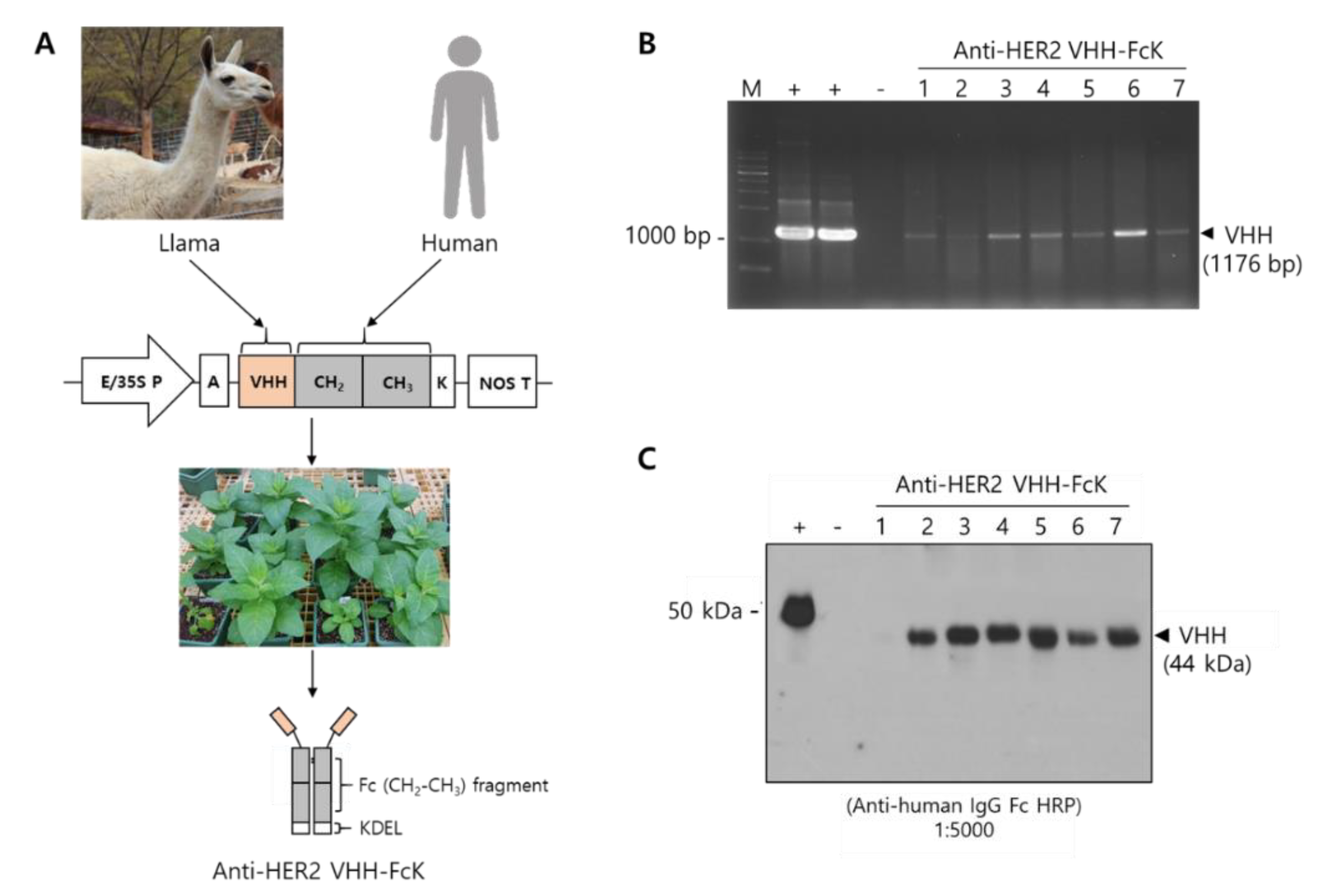
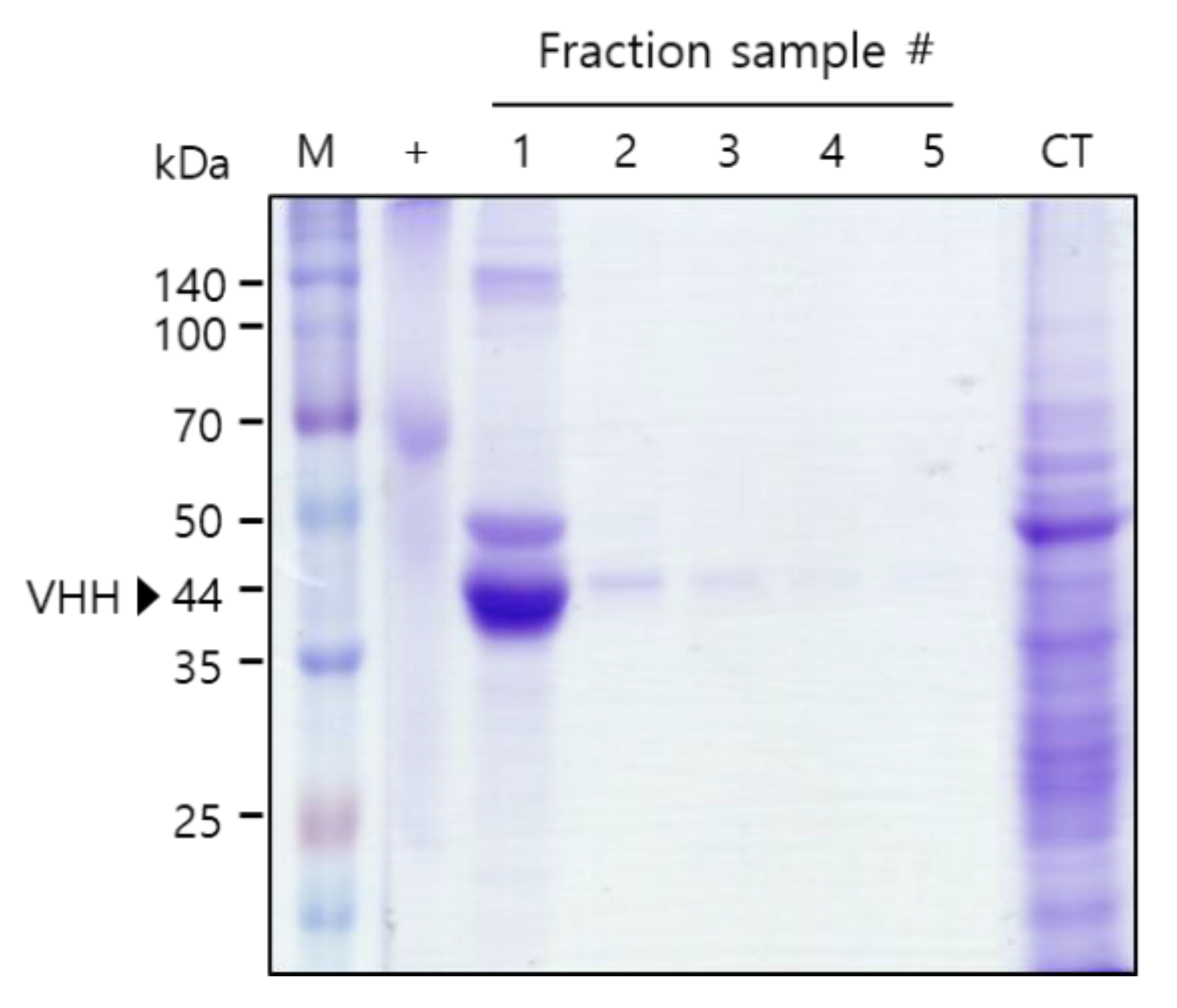
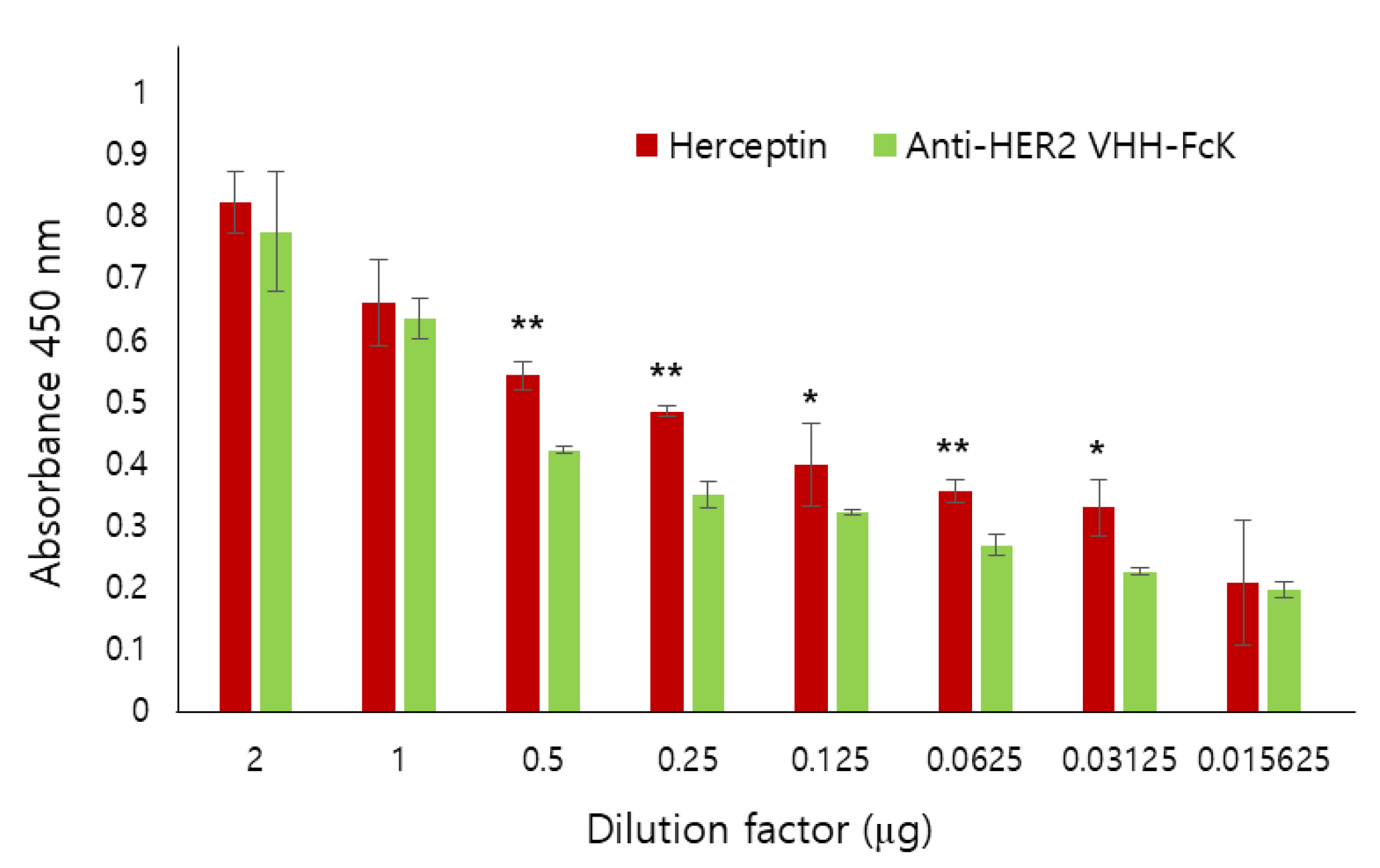

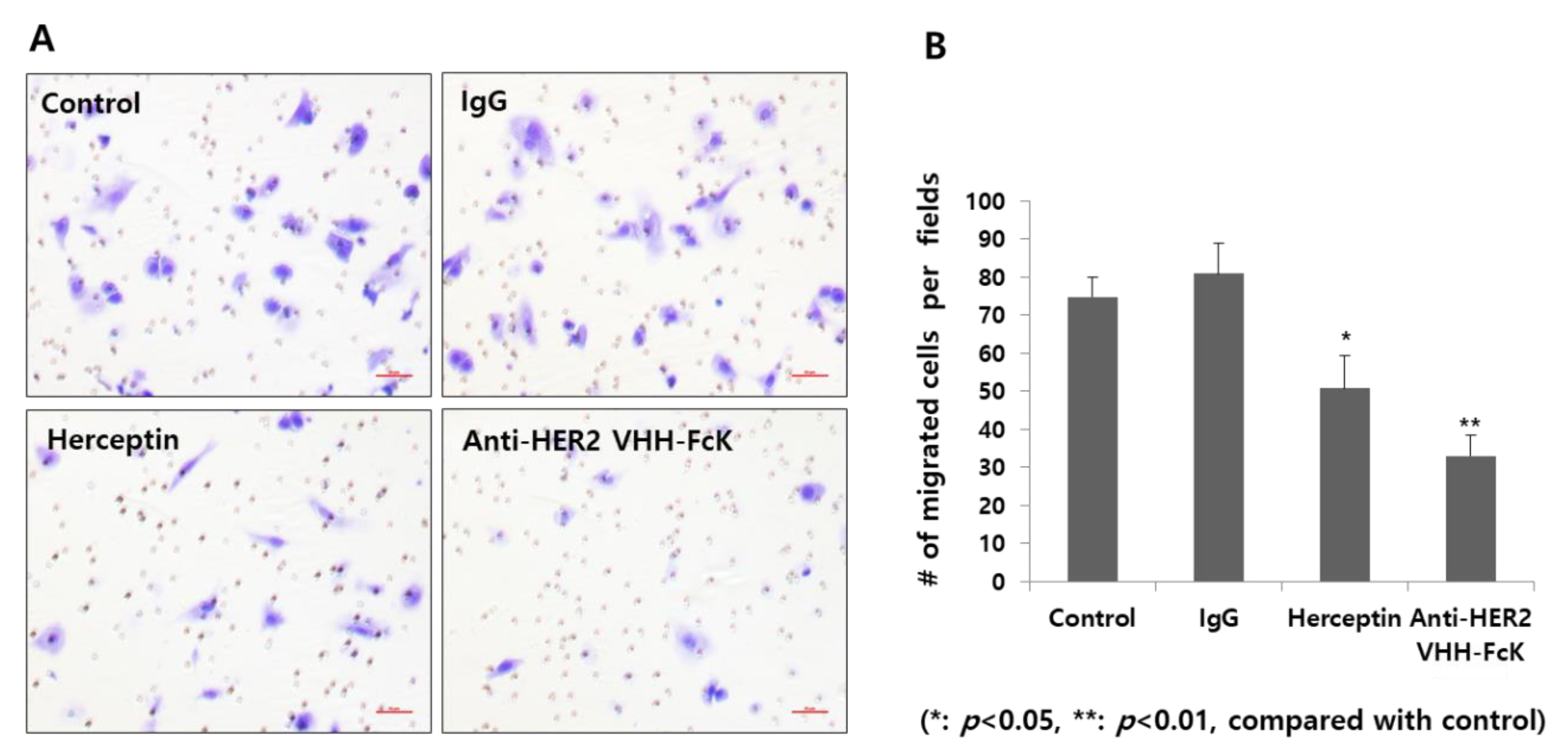
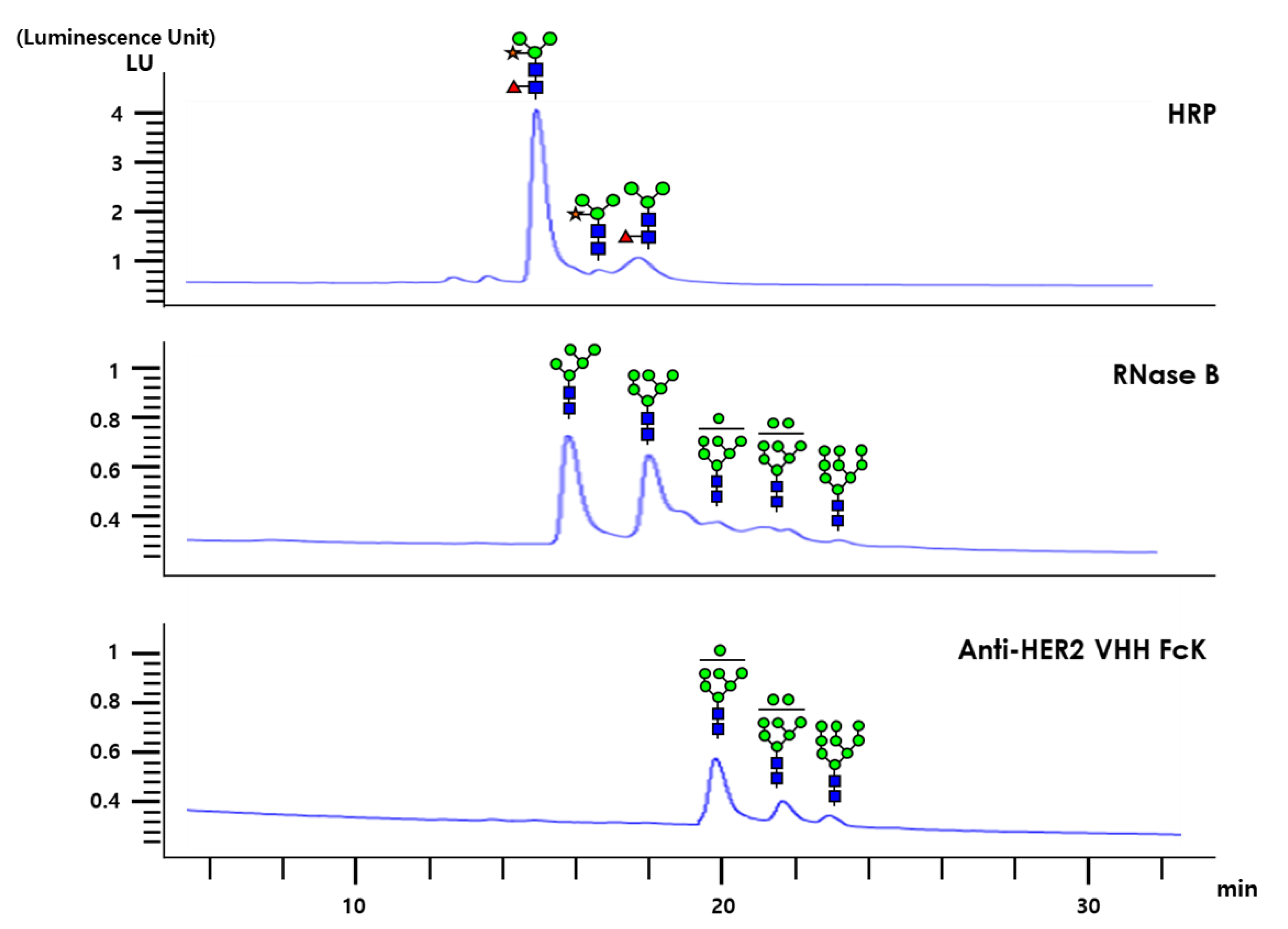
© 2020 by the authors. Licensee MDPI, Basel, Switzerland. This article is an open access article distributed under the terms and conditions of the Creative Commons Attribution (CC BY) license (http://creativecommons.org/licenses/by/4.0/).
Share and Cite
Park, S.R.; Lee, J.-H.; Kim, K.; Kim, T.M.; Lee, S.H.; Choo, Y.-K.; Kim, K.S.; Ko, K. Expression and In Vitro Function of Anti-Breast Cancer Llama-Based Single Domain Antibody VHH Expressed in Tobacco Plants. Int. J. Mol. Sci. 2020, 21, 1354. https://doi.org/10.3390/ijms21041354
Park SR, Lee J-H, Kim K, Kim TM, Lee SH, Choo Y-K, Kim KS, Ko K. Expression and In Vitro Function of Anti-Breast Cancer Llama-Based Single Domain Antibody VHH Expressed in Tobacco Plants. International Journal of Molecular Sciences. 2020; 21(4):1354. https://doi.org/10.3390/ijms21041354
Chicago/Turabian StylePark, Se Ra, Jeong-Hwan Lee, Kibum Kim, Taek Min Kim, Seung Ho Lee, Young-Kug Choo, Kyung Soo Kim, and Kisung Ko. 2020. "Expression and In Vitro Function of Anti-Breast Cancer Llama-Based Single Domain Antibody VHH Expressed in Tobacco Plants" International Journal of Molecular Sciences 21, no. 4: 1354. https://doi.org/10.3390/ijms21041354
APA StylePark, S. R., Lee, J.-H., Kim, K., Kim, T. M., Lee, S. H., Choo, Y.-K., Kim, K. S., & Ko, K. (2020). Expression and In Vitro Function of Anti-Breast Cancer Llama-Based Single Domain Antibody VHH Expressed in Tobacco Plants. International Journal of Molecular Sciences, 21(4), 1354. https://doi.org/10.3390/ijms21041354





